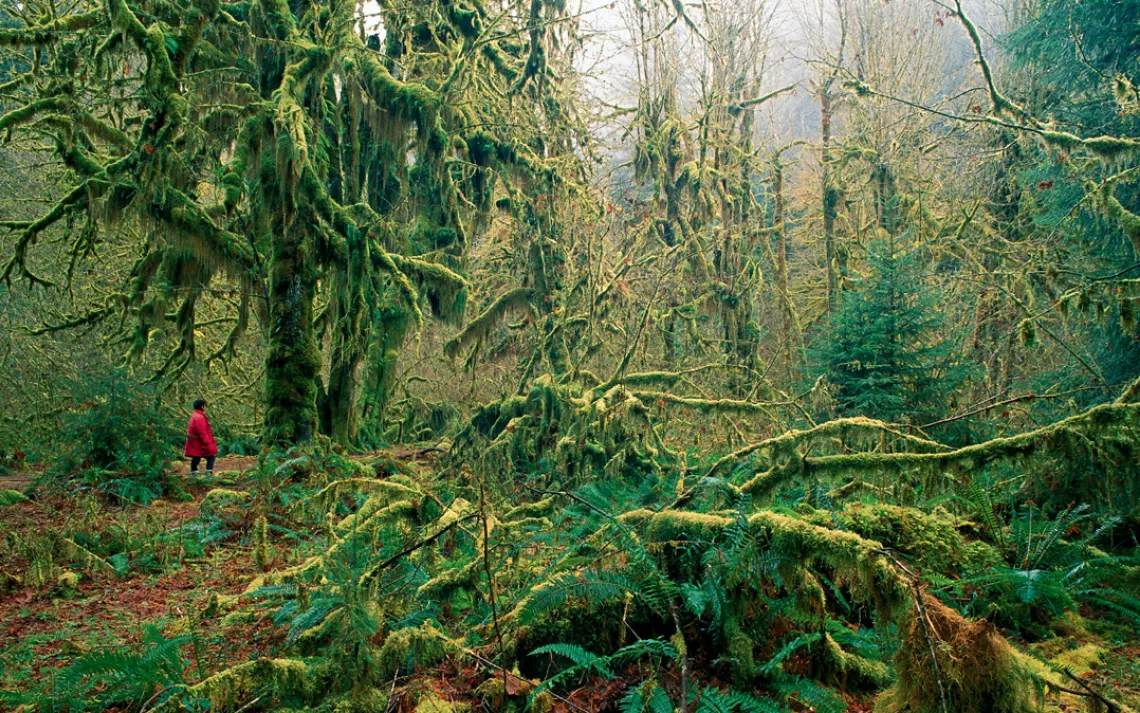Looking for the Real Silent Night
The One Square Inch of Silence within Olympic Park's Hoh Rain Forest

Tread softly in Olympic National Park's Hoh Rain Forest, the most pristine soundscape in the Lower 48. | Photo by Jean-Paul Ferrero/Auscape/Minden Pictures
Twilight races us down the trail, shadowed by the implacable pillars of 250-foot-tall Douglas firs. Color blanches from the landscape as we thread along the river basin's belly. "Go, go, go!" chides my friend Madeline. "Sunset's at 4:17. We need that tent up first!"
Overwhelmed by holiday bustle a week before the winter solstice, we'd skipped out from Seattle to backpack the most silent spot in the continental United States, up the Hoh River Trail in Washington's Olympic National Park. Here we'd reboot our overtaxed senses among the quiet green tangle of the hemisphere's largest intact temperate rainforest.
Dusk transforms every bare branch into a character from The Nightmare Before Christmas. Our head-lamp beams snag on new spruce tips, bright as reflective safety piping. We dart into a riverside campsite and secure the fly just as darkness descends. Now I just have to wait 8 to 10 hours until my screen-addled, night-owl brain can settle into sleep. Despite the frost filigreeing its sides, the tent still reeks of Burning Man. We decide to take a walk.
"Let's look for the Inch," Madeline suggests. The One Square Inch of Silence is an eraser-size rock the color of a salmon steak, balanced on a log 3.2 miles from the trailhead, that celebrates the most undisturbed soundscape in the Lower 48. It was created in 2005 by acoustic ecologist Gordon Hempton as an unofficial sanctuary within the park. Artificial noises are baffled by the ocean, the snow-gilded crags, and 239 cloudy days per year. Hempton even sweet-talked three airlines into rerouting maintenance and training flights to avert the funnels of noise that their jets emit.
The Inch, for the record, lies at 47° 51.959N, 123° 52.221W. This information is very useful unless you leave your GPS at home and then go thrashing around in the murk, as Madeline and I are doing. We startle at a giant Cthulhu root ball and clamber over a pick-up-sticks stream crossing. Every few hundred feet, we stop and listen. The fast-rushing Hoh River grinds boulders smooth on its bed. Dewdrops weep in the dense understory. We hear the brush of a wing and tilt our heads up to see Geminid meteors igniting the sky, quicksilver and silent.
We don't find the Inch that evening, but it doesn't matter. We've left the winter city far behind, with its holiday songs, Salvation Army bells, and tinkle of office-party ice cubes.
Here we are among the salmon and otters and northern spotted owls. The silent night stretches deep around us.
"Quiet outdoors means very little is happening," Hempton once told me. "Your brain can gather all the surrounding sounds—it doesn't have to sift and prioritize. It's beautiful when your body truly relaxes, realizing there's no threat."
Shhhhh. If you listen closely enough, the echo's still there, carrying peace into the new year.
 The Magazine of The Sierra Club
The Magazine of The Sierra Club



